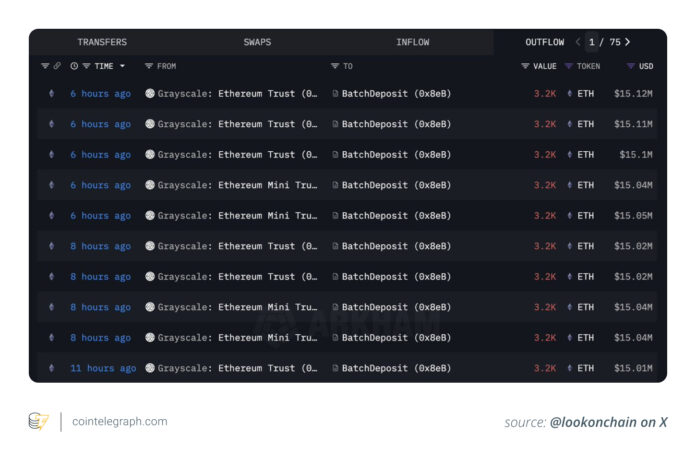Introduction to Crypto Staking and Its Institutional Barriers
Crypto staking has emerged as a vital component of the Proof-of-Stake (PoS) blockchains, enabling participants to secure and validate transactions in exchange for rewards. Unlike the energy-intensive Proof-of-Work (PoW) model, PoS systems rely on invested capital and validator performance, making them more energy-efficient and accessible. However, institutional investors have been hesitant to participate in crypto staking due to the significant capital requirements, technical expertise, and risks associated with operating validation nodes.
Grayscale Investments, a leading digital asset manager, has bridged the gap between traditional finance and decentralized cryptocurrency by launching the first publicly traded staking investment vehicle. This innovative product allows investors to earn blockchain rewards without the need for running validator nodes or managing complex technical and custody risks. Grayscale’s Ether and Solana ETPs are the first in the US to combine spot crypto exposure with staking rewards, providing returns via the fund’s net asset value or direct payouts.
Grayscale’s Role in Crypto Institutionalization
Grayscale has played a pivotal role in the institutionalization of crypto, offering regulated and easy-to-use investment products that enable investors to access cryptocurrencies without the hassle of managing wallets or dealing with validator risks. The company’s staking-enabled products, such as Grayscale Ethereum Trust (ETHE) and Grayscale Solana Trust (GSOL), have integrated the yield-generating functions of blockchain networks with the regulatory and custody standards of traditional finance.
By leveraging trusted custodians, a diversified network of validation partners, and transparent reporting, Grayscale has created a safe and compliant way for investors to participate in staking. This has transformed staking from a complex, retail-focused process to a professional investment opportunity, attracting significant new capital to these networks and serving as a model for products linked to other PoS blockchains or tokenized assets.
Regulatory and Market Changes
The launch of Grayscale’s staking-enabled funds represents an important milestone driven by evolving regulation and growing market competition. The US Securities and Exchange Commission issued guidance for crypto ETPs in May 2025, clarifying that certain custody activities may operate within the limits of existing securities laws when managed through regulated custodians and transparent structures. This development has removed previous barriers that prevented ETFs from earning on-chain rewards.
Meanwhile, competition has heated up as major players such as BlackRock and Fidelity have entered the crypto ETF space, driving innovation and prompting Grayscale to introduce stakingable ETPs that combine income generation with traditional fund frameworks. Educational initiatives, such as “Stake 101: Secure the Blockchain, Earn Rewards,” have been launched to promote transparency and understanding, increasing investor confidence in these new products.
How Grayscale’s Spot Crypto ETPs Provide Investors with Staking Yield
Grayscale Ethereum Trust (ETHE) and Grayscale Ethereum Mini Trust (ETH) are spot Ether ETPs that now support on-chain staking, while Grayscale Solana Trust (GSOL) has enabled staking in over-the-counter trading. These offerings are the first US-listed products to combine spot crypto exposure with staking rewards, paying returns via the fund’s net asset value or direct payouts.
Operationally, Grayscale leverages institutional custodians and a diversified network of validator providers for passive staking, managing risks such as curtailments or downtime while supporting liquidity. Clear disclosures, reports, and compliance with regulatory frameworks increase investor confidence in these innovative products.
Risks and Criticism of Grayscale’s Deployment Funds
Regulatory uncertainty remains a key issue for staking-enabled products, with concerns surrounding the structural differences between ETPs and fully registered ETFs under the Investment Company Act of 1940. Operational risks, such as validator performance issues and liquidity locks, also exist, and the launch of these products presents another challenge in terms of competition with Ether ETFs.
Concerns about decentralization are also important, as institutional staking can increase validator control and grant big money outsized influence over the governance and network security of the underlying blockchains. This could contradict the basic principles of decentralization, highlighting the need for careful consideration and oversight in the development of these products.
Conclusion
Grayscale’s staking-enabled ETPs have had a significant impact on Wall Street and the broader crypto ecosystem, connecting blockchain-based yields with regulated financial products and transforming crypto ETPs from simple price trackers into income-generating assets. As the crypto market continues to evolve, it is essential to consider the potential risks and benefits of these innovative products, ensuring that they align with the principles of decentralization and transparency that underlie the blockchain ecosystem.
For more information on Grayscale’s staking-enabled ETPs and their impact on the crypto market, visit https://cointelegraph.com/news/how-grayscale-brought-crypto-staking-to-wall-street-for-the-first-time?utm_source=rss_feed&utm_medium=rss_category_analysis&utm_campaign=rss_partner_inbound

